One of the most important elements of a personal computer that affects its performance is RAM. Increasing the amount of RAM, in most cases, will increase the speed of the PC.

Necessary
- - Crosshead screwdriver;
- - Everest.
Instructions
Step 1
RAM modules are divided into four main types: DIMM (legacy format), DDR1, 2, and 3. First, find out what type of memory modules are used in your computer. To do this, install the Everest program. You can download the utility from the official website of the developers
Step 2
Install the program. Run it and wait for a while while the utility collects information about the system and connected equipment. In the left column of the main menu, find the Motherboard tab and expand it. Go to SPD.
Step 3
The column "Description of the device" will display the names of the connected RAM modules. Select one of them and look at the data in the "Memory type" field. Examine the specifications displayed in the Memory Timings menu. Better to view the readings of all installed RAM cards.
Step 4
Purchase new RAM modules. Select the type of bracket that is supported by your computer's motherboard. The frequency of operation of the modules should not be lower than the frequency of the installed elements. This will degrade the performance of the currently connected boards. There is also no point in purchasing modules that are much better than the installed ones.
Step 5
Disconnect the computer system unit from the AC power. Open the block case. Install new memory modules into dedicated slots. In the event that you have purchased an even number of new brackets, connect them to those ports that work in dual-channel mode. This method allows you to slightly increase the total performance of the RAM strips.
Step 6
If a BSoD error appears when you turn on your computer for the first time, remove absolutely all RAM modules. Connect them one at a time. This will allow the system to define new slats.






